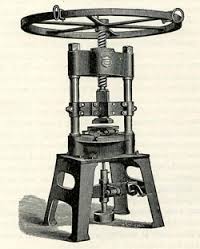8 Little Known Facts about the Screw and screw press
Author: haloong Time: 2016-11-18 15:57:47
5) Screws press machine were originally used as fasteners for fixing two relatively thin pieces of material together.
Nails are more effective when they are longer. Even a tiny screw when properly installed will remain permanently fixed. To remove a screw without a screwdriver, one actually has to cut away the surrounding material.
6) Although screws were in use as fasteners by the mid-fifteenth century, factory production of screws didn’t start until the mid-1700’s.
As a screw manufacturer, it’s hard to imagine screws punching machine being carved by hand. Whole families literally worked day and night to file threads and cut slots in the heads of the screws. In England, blacksmiths delivered large quantities of nails formed with heads to families who then cut a slot in the head and laboriously filed the threading by hand. Not surprisingly, this tedious labor produced poor results-the screws were uneven with shallow threads. The cost of producing screws in this manner was so high that screws were sold individually.
7) The first screw factory was a financial failure.
In 1760 England, Job and William Wyatt patented a design for a machine that could produce screws automatically. It took them 16 years to raise the capital to open a factory. The Wyatt’s machine made a labor of several minutes into one of six or seven seconds while producing a much higher quality product. For some reason, the Wyatt brothers’ business was not successful. Their successors, however, were able to make their business profitable and produced 16,000 screws a day with a team of 30 people.
8) A machine for producing tapered threads was not invented until 1842.
At the time, the lathes that produced electric screws pressing machinewere incapable of producing the tapered threading visible on a modern screw. Without tapering, the thread could not continue until the tip of the screw. This meant that a hole needed to be drilled before a screw could be installed. In the 1840’s, several American manufacturers received patents for machines that could produce a tapered thread. This technological innovation helped the United States become the most important haloong screw manufacturer in the world.
and now,Haloong machinery screw presses is the most advanced electric screw press machinery is the perfect substitute of friction press.applied in refractory material molding,manual tool,all kinds of bricks、tiles,and metal forging ,building material,electric,and high alumina brick,clay brick,Magnesite brick, honeycomb lattice brick, andalusite brick, lightweight insulation brick, special-shaped brick, brick burner combination, carbon brick, silica brick, phosphate brick, alumina magnesia carbon brick, refractory ball.
Nails are more effective when they are longer. Even a tiny screw when properly installed will remain permanently fixed. To remove a screw without a screwdriver, one actually has to cut away the surrounding material.
6) Although screws were in use as fasteners by the mid-fifteenth century, factory production of screws didn’t start until the mid-1700’s.
As a screw manufacturer, it’s hard to imagine screws punching machine being carved by hand. Whole families literally worked day and night to file threads and cut slots in the heads of the screws. In England, blacksmiths delivered large quantities of nails formed with heads to families who then cut a slot in the head and laboriously filed the threading by hand. Not surprisingly, this tedious labor produced poor results-the screws were uneven with shallow threads. The cost of producing screws in this manner was so high that screws were sold individually.
7) The first screw factory was a financial failure.

In 1760 England, Job and William Wyatt patented a design for a machine that could produce screws automatically. It took them 16 years to raise the capital to open a factory. The Wyatt’s machine made a labor of several minutes into one of six or seven seconds while producing a much higher quality product. For some reason, the Wyatt brothers’ business was not successful. Their successors, however, were able to make their business profitable and produced 16,000 screws a day with a team of 30 people.
8) A machine for producing tapered threads was not invented until 1842.
At the time, the lathes that produced electric screws pressing machinewere incapable of producing the tapered threading visible on a modern screw. Without tapering, the thread could not continue until the tip of the screw. This meant that a hole needed to be drilled before a screw could be installed. In the 1840’s, several American manufacturers received patents for machines that could produce a tapered thread. This technological innovation helped the United States become the most important haloong screw manufacturer in the world.
and now,Haloong machinery screw presses is the most advanced electric screw press machinery is the perfect substitute of friction press.applied in refractory material molding,manual tool,all kinds of bricks、tiles,and metal forging ,building material,electric,and high alumina brick,clay brick,Magnesite brick, honeycomb lattice brick, andalusite brick, lightweight insulation brick, special-shaped brick, brick burner combination, carbon brick, silica brick, phosphate brick, alumina magnesia carbon brick, refractory ball.







